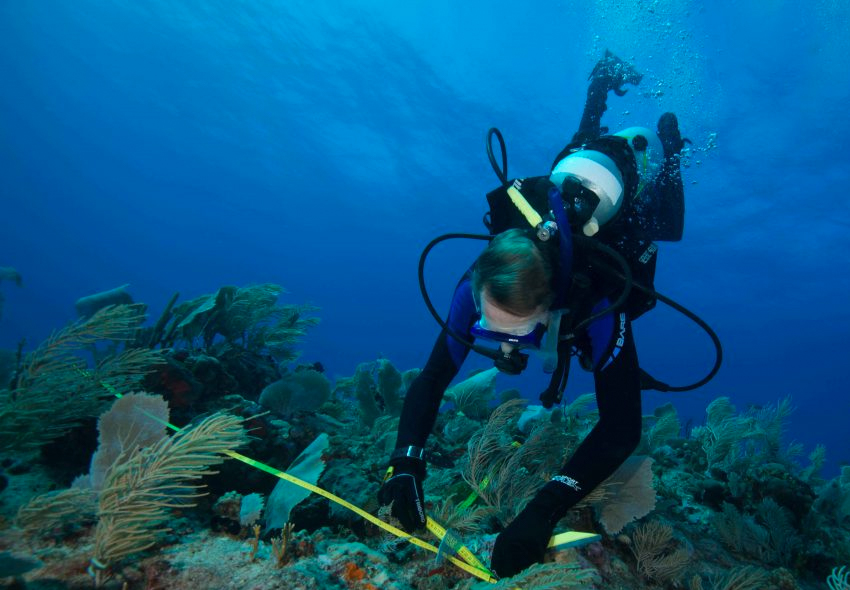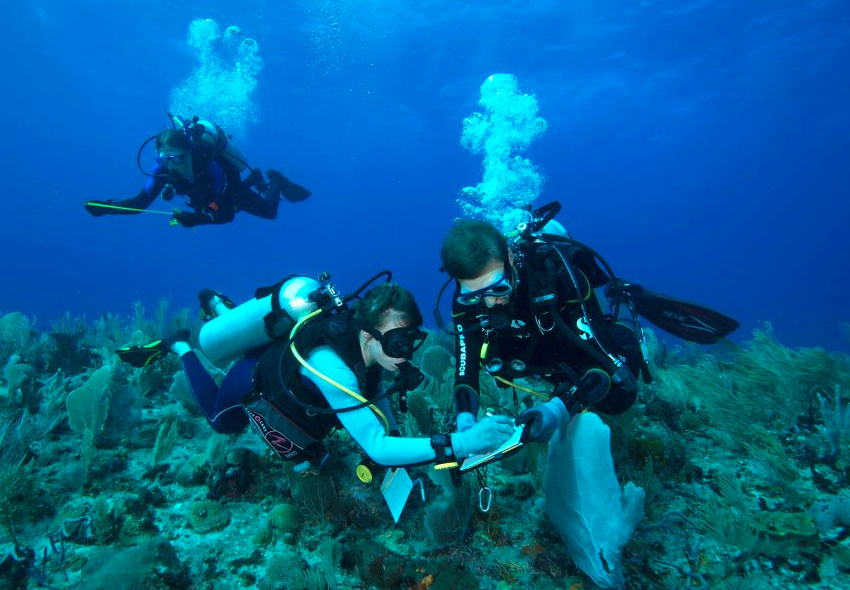Make or break
26 November 2018,In the distance we see only some lights from Statia and Saba and beyond that, the light of the moon, the stars and the sound of the waves crashing on the Caribbean Explorer II. While we spent the last few nights near Saba, we will now actually sleep on the Saba Bank. Many semi seasick people at breakfast, and not everyone is in the mood for a ‘sunny side up’ anymore. Fortunately there are still the magic pills against seasickness that do their job perfectly. The advantage is that we now stay close to our dive sites and that saves a lot of sailing time. This is good, since we have to make an inventory of three different locations on the Saba Bank every day with two research teams. In fact, we make 6 dives a day.
GORGONIAN DELIGHT
It is half past nine and diving team 1 jumps overboard and starts her swim towards the newly thrown buoy at our dive site “Gorgonian delight”. Due to the strong current, it is important to jump into the water quickly, so that the last diver can reach the buoy without any problems. The first diving team places three transect lines of 50 m each over the bottom to count fish, along which we then take the other measurements. Exactly 30 minutes after team 1 started their dive, my team 2 jumps into the water.
DROWNING
Today, together with my buddies Didier, Alice and Yun, I take measurements to help determine whether the reef grows or crumbles net. This is important in view of the fast rising sea level. After all, if the reef does not grow hard enough, it has a chance to drown. This works as follows: corals live in coexistence with algae, also known as zooxanthellae. With the help of sunlight, the algae make sugars that the corals in turn use to deposit calcium, so that the reef grows. Since less sunlight penetrates into deeper water, you will find most coral communities in relatively shallow water. But if the reef does not grow as fast as the sea level rises, the reef catches less and less light and therefore grows less and less hard. In addition to sea level rise, global warming is also a threat to the reef. Due to the increasing emission of greenhouse gases the seawater becomes more acidic, making it more difficult for the corals to deposit calcium. So it can happen that a coral reef slowly drowns.
CALCIUM BUDGET
The reef grows because corals and algae deposit calcium. At the same time, sponges, sea urchins, parrot fish and other animals are responsible for the degradation of the reef. Many of these organisms do better in the reef environment that has been changed by human intervention. The difference between growth and degradation is the calcium budget. In order to map the degradation, my buddy Didier therefore counts the number of sea urchins and the surface of boring sponges. The parrotfish are already counted by the fish team. It’s my task to measure the complexity of the reef along the transect. With a real measuring tape I measure the contours of the corals and other seafloor organisms. If you compare that length with the length over the bottom you get a standardized measure for the relief of the reef. The structural complexity that corals give to the reef ensures that the reef can function properly and because of this there is also more space and hiding place for other animals.
SEAFLOOR DIVERSITY
As we descend along the bowline to relieve team 1, a nurse shark quietly swims around. As the name of the dive site suggested, there are a lot of gorgonians here, which are waving in the current. During the measurement it appears that there is clearly less structure on this reef than on many of the other locations that we have investigated. I wonder how that is possible. I am guessing that it has to do with the strong current, which makes it extra easy for the gorgonians to filter their food out of the water. It really amazes me that our research locations are so incredibly different. The enormous diversity of seafloor communities we find is more than worth protecting!
RELATED BLOGS
|
NOV 16 |
19 |
20 |
23 |
24 |
26 |
29 |
30 |
EXPEDITION SABA BANK III
NOV 2018

MATHIJS VAN DER GEEST
WAGENINGEN MARINE RESEARCH


